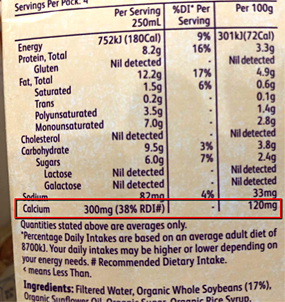Top Tips On How To Include Calcium Foods
Top Tips On How To Include Calcium Foods
Some handy hints on how to include calcium in your child's diet if they are allergic to cow's milk.
Use an alternative milk with added calcium
You might like to first read about calcium needs.
Find out about calcium needs for children with cow's milk allergy
Make sure the milk alternative you use has added calcium. Check the nutrition label and aim for one with at least 120mg calcium per 100mls. 100mls is the same as 100g.
Soy milk is the first choice of alternative milk to cow's milk. DON’T use A2, goat or sheep milk as these have either cow's milk protein or have very similar proteins to cow's milk. Your child may still react to these milks. If your child cannot tolerate soy, then you will need an alternative.
The following milks are not recommended if your child is under 1 year of age, and ideally not until they are over 2 years of age. Seek dietitian guidance to discuss the best option for your child when they are under 2 years of age.
- oat milk
- rice milk
- almond milk
- cashew milk
Check the nutrition label to see how much calcium there is in the food or drink.

Use cereal with added calcium
Choose a cereal that has added calcium, (read the label) and serve this with fruit, fortified yoghurt or soy dessert and alternative milk.
Use a dairy free yoghurt fortified with calcium
Not all dairy free yoghurts have calcium. Check the one you use is fortified with calcium. Check the nutrition label and aim for one with at least 120mg calcium per 100mls.
Use milk alternatives in your cooking
You can use a milk alternative to make white sauce, custards, rice pudding or in baking. Using milk alternatives in cooking can be especially useful if your child will not drink much alternative milk. You can mix the white sauce through pasta or vegetables. Sprinkle with calcium fortified dairy free cheese.
Use almonds for snacks and baking
Use almonds for snacks and baking. You can also use almond meal or flour and soy flour in baking.
Use seeds in baking
Sprinkle chia seeds, poppy seeds and LSA (ground linseeds, sunflower and almonds) on cereals. You can use them with breadcrumbs when crumbing or adding a crumb topping. You can also include them in baking. Add them if making bliss balls.
Try using tahini
You can include tahini in stir fries, casseroles or in hummus. Try spreading it on crackers or toast.
Grate some Angel Foods cheddar, mozzarella, or smoked
You can grate or melt Angel Foods cheddar, mozzarella, or smoked dairy free cheese. It's good on pizza or in a toasted sandwich, or just grated in a wrap or homemade burger. You can also use it for making a cheese sauce or put some on crackers for a snack. These cheeses do not keep for long in the fridge but they freeze well.
Give your child extra fruit and vegetables
Include dried figs, or some fresh fruit, eggs, broccoli, kale, silverbeet or spinach and rocket on a regular basis to help increase your child's calcium intake.
Remember to check labels of all foods and fluid products to make sure they do not include allergens your child reacts to.
This page last reviewed 08 December 2022.
Do you have any feedback for KidsHealth?
If you have any feedback about the KidsHealth website, or have a suggestion for new content, please get in touch with us.
Email us now